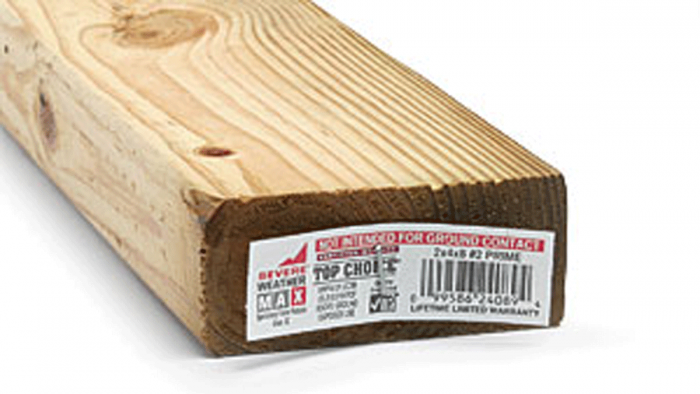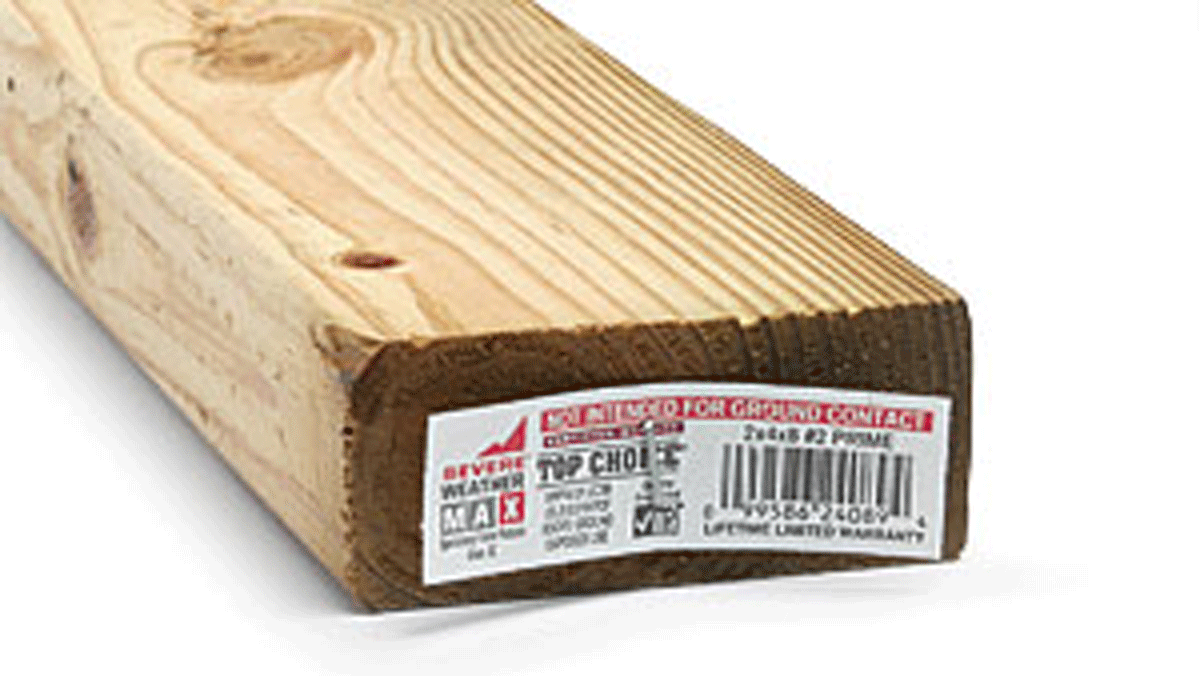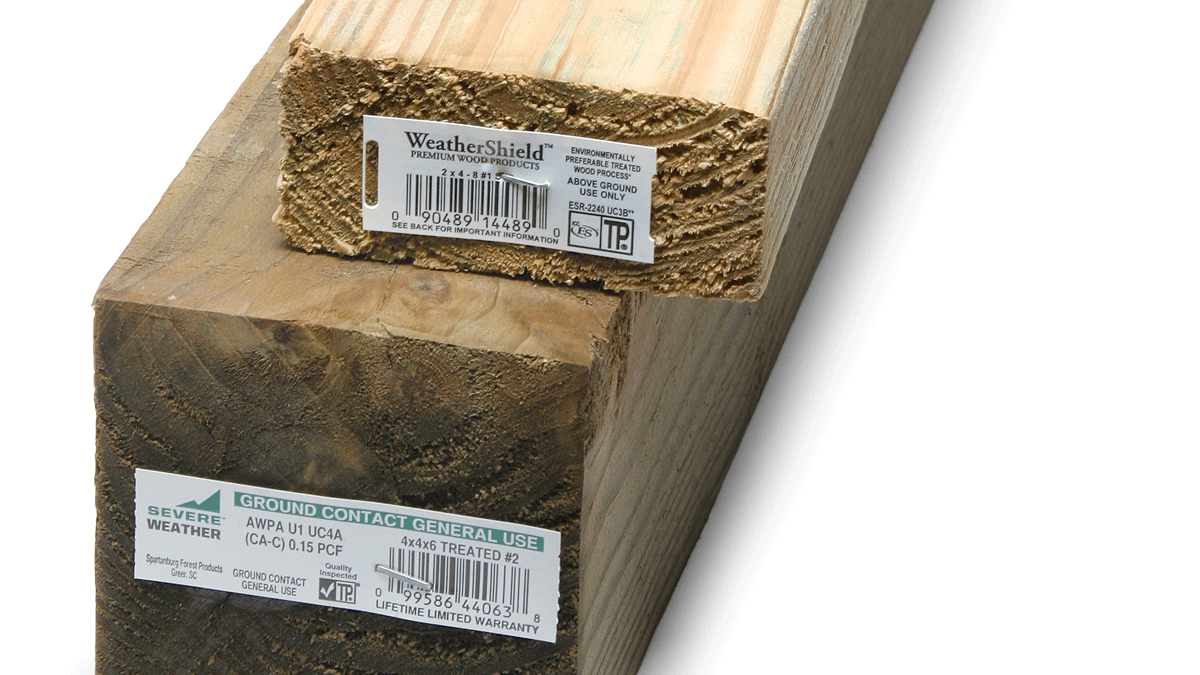What’s the Difference: Pressure-Treated Lumber
Learn more about the various types of pressure-treated lumber, where you can find the retention level, and why making the right choice is so crucial.

Until 2004, pressure-treated wood for residential use was preserved with chromate copper arsenate (CCA), and the level of treatment was generally the same for all lumber. Because of concerns over arsenic’s toxicity, CCA has since been replaced for residential use by a host of preservatives, some of which have themselves been replaced by even newer formulations. Compared to CCA, these preservatives contain higher amounts of copper, which is expensive, so manufacturers produce pressure-treated lumber with different retention levels.
Retention level measures how much of the preservative is retained in the wood after the pressure treatment ends. It’s expressed in pounds per cubic foot (lb. per cu. ft.) of wood fiber. The higher the retention level, the better equipped the wood is to ward off decay from insects and moisture. Wood with a lower retention level has a lower amount of copper and, therefore, a lower cost.
In order to get to the required retention level, some species of lumber (such as Douglas fir, hem-fir, and spruce-pine-fir) have to be incised, which allows the preservative to penetrate the wood more deeply and uniformly. Tests conducted by Forest Product Laboratory have found that this practice results in a reduction in bending strength and stiffness. For this reason, incising is more common with timbers and more substantial boards.
Use the right fasteners and hardware
It’s important to know retention levels not only because you don’t want to pay for lumber rated for ground contact if you’re installing a mudsill or framing a raised deck, but also because the copper content of these preservatives should guide your choice of fasteners and hardware. Copper is corrosive, so this choice is crucial. Generally, fasteners and hardware made from stainless steel and hot-dipped-galvanized (HDG) steel are recommended for pressure-treated lumber. However, lumber with the highest retention levels—such as that used in coastal and below-grade applications—should be used with stainless steel only, which is more resistant to corrosion than HDG steel. And of course, if you’re using fasteners made of stainless steel, you must use stainless-steel hardware; combining stainless-steel fasteners with HDG hardware (and vice versa) will result in faster corrosion of the galvanized parts.
ACQ and CA
Most of the preservatives used for treating wood intended for residential applications fall into two categories. In the first category are alkaline copper quaternary (ACQ) and two formulations of copper azole (CA-B and CA-C). The American Wood Protection Association (AWPA) has established minimum retention levels for wood treated with these preservatives (see below). The label of a board treated with ACQ or CA lists the retention level.
MCQ and MCA
The second category of preservatives includes wood treated with two variations of ACQ and CA: micronized copper quaternary (MCQ) and micronized copper azole (MCA). Unlike with ACQ and CA, in which the copper is dissolved chemically in an organic solvent, the copper in MCQ and MCA is present in microscopic particles suspended in water. Significantly, this makes the copper less corrosive to fasteners and hardware than the copper in wood treated with ACQ and CA; moreover, it can be placed in contact with aluminum. Another advantage is that wood treated with MCQ and MCA keeps more of its natural color.
MCA- and MCQ-treated wood has not been tested by the AWPA. Instead, manufacturers have sent their products to the International Code Council Evaluation Service (ICC-ES), which provides research reports on innovative building products that it deems equivalent to standardized products. For each product, the ICC-ES report provides a minimum retention level. The labels for these products, however, usually just state “above ground,” “ground contact,” or “ground contact/freshwater use,” which correspond to progressively higher retention levels.
AWPA minimum retention levels (in lb. per cu. ft.)
Preservative: ACQ
Above ground: 0.15
Ground contact: 0.40
Ground contact, heavy duty: 0.60
Preservative: CA-B
Above ground: 0.10
Ground contact: 0.21
Ground contact, heavy duty: 0.31
Preservative: CA-C
Above ground: 0.06
Ground contact: 0.15
Ground contact, heavy duty: 0.31
Is it green, or isn’t it?
 In 2002, Chemical Specialties received a Presidential Green Chemistry Challenge Award from the EPA for its development of ACQ. A summary on the EPA’s website says, “Replacing CCA with ACQ is one of the most dramatic pollution prevention advancements in recent history.”
In 2002, Chemical Specialties received a Presidential Green Chemistry Challenge Award from the EPA for its development of ACQ. A summary on the EPA’s website says, “Replacing CCA with ACQ is one of the most dramatic pollution prevention advancements in recent history.”
Pressure-treated wood has sometimes had a difficult time being considered an environmentally friendly product, however. This perception persists despite the fact that by extending the life of the wood, the same chemicals that are cause for concern mean that fewer trees have to be cut down.
Wood treated with MCQ and MCA has added a new element of confusion. Some of these products have received recognition from third-party environmental certifiers. For example, Australia-based EcoSpecifier has identified Wolmanized lumber as a Verified Product, and the MicroPro treatment has been certified as an Environmentally Preferable Product by Scientific Certification Systems. At the same time, there are concerns about the presence of nanoparticles of copper—that is, particles that are 1 to 100 nanometers in at least one dimension—in these formulations. (A nanometer is a billionth of a meter.)Materials that small have different properties, and the potential toxicity of nanoparticles of copper has not been established. The EPA’s website includes this statement: “EPA is working with the Consumer Product Safety Commission to evaluate if there are any potential human and environmental effects from exposure to micronized copper.”
The greenest preservatives used in residential construction may well be two newer formulations that include no copper or any other metal: EL2 (sold in Ecolife-branded lumber) and PTI (sold in lumber branded as Wolmanized EraWood and Wolmanized L3 Outdoor Wood). Because these preservatives are nonmetallic, there is no danger of any metal leaching out over time, and corrosion of fasteners and hardware is less likely. The AWPA has established minimum retention levels for EL2 and PTI, but only for above-ground use, so wood treated with these chemicals is limited to places where it won’t be in prolonged contact with water.
Photos: Rodney Diaz
From Fine Homebuilding #249
For more information:






